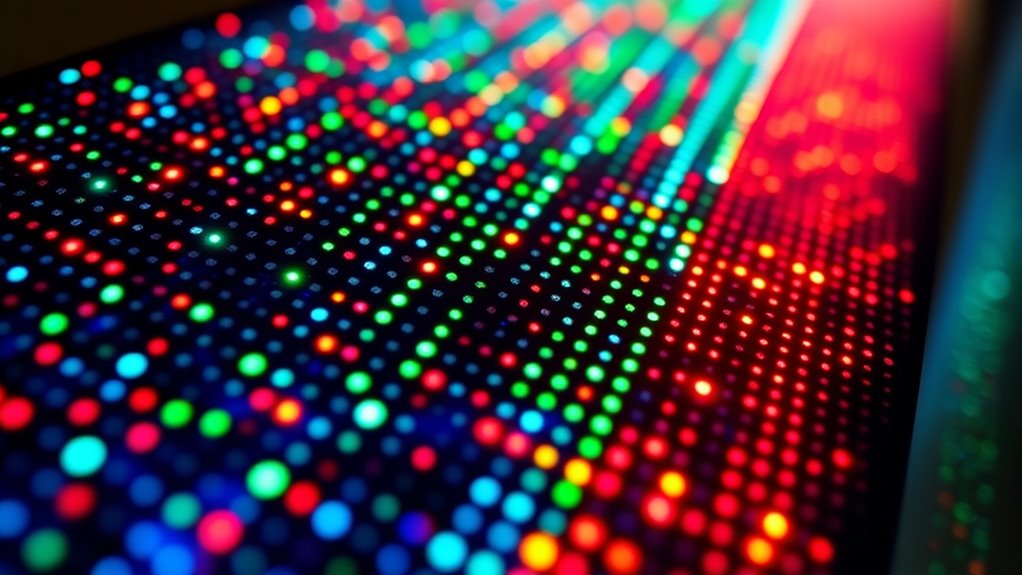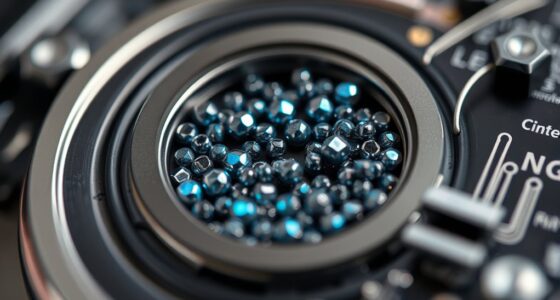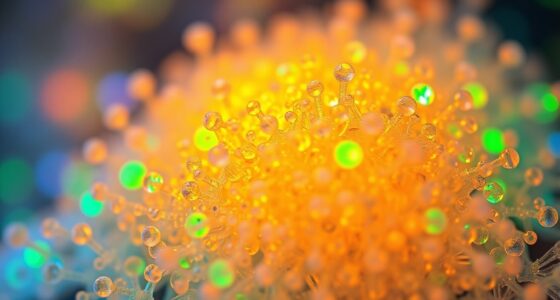Quantum dots enhance display technology by delivering brighter, more vivid images with richer reds, greens, and blues. They improve color accuracy, making visuals look more realistic and engaging. Thanks to scalable manufacturing, these displays are becoming more affordable and widely available across different devices. You’ll notice sharper contrast and better image quality, whether for entertainment or professional work. If you want to discover how this technology is transforming your screens, keep exploring further.
Key Takeaways
- Quantum dots produce brighter, more vibrant images with richer reds, greens, and blues, enhancing overall display quality.
- They enable accurate color representation and improved color fidelity for professional and consumer displays.
- Quantum dot manufacturing is scalable and cost-effective, allowing for widespread adoption across various device types.
- Their integration results in displays with better contrast, sharpness, and reliability, improving the visual experience.
- Industry trends show ongoing refinement, leading to more accessible, high-quality displays with advanced visual performance.

Quantum dots have revolutionized display technologies by offering brighter, more vibrant images with improved color accuracy. When you look at a screen enhanced with quantum dot technology, you’ll notice richer reds, greens, and blues that make images pop more vividly than traditional displays. This enhancement isn’t just about aesthetics; it considerably boosts your viewing experience by providing truer, more precise colors, which is especially important for professional work like photo editing, graphic design, or any activity where color fidelity matters. The ability of quantum dots to emit specific wavelengths of light ensures that colors on the screen are more accurately represented, giving you a viewing experience that’s both stunning and reliable.
One of the key advantages of quantum dots is their potential for manufacturing scalability. As the demand for high-quality displays increases, manufacturers have worked to streamline production processes, making quantum dot technology more accessible and cost-effective. Unlike earlier display enhancements that required complex and expensive manufacturing procedures, quantum dots can be produced using scalable methods that suit mass production. This means you’re more likely to find quantum dot-enhanced screens in a wide range of devices—from premium TVs to budget smartphones—without a substantial jump in price. The scalability also allows for consistent quality across large batches, ensuring that each device meets high standards for color accuracy and brightness.
Furthermore, the manufacturing scalability of quantum dots enables manufacturers to improve yields and reduce costs, which benefits you as a consumer. You get access to high-performance displays at more affordable prices, and the technology can be integrated into various screen sizes and formats with ease. This flexibility opens up possibilities for innovative display designs that maintain high color accuracy without sacrificing production efficiency. As the industry continues to refine manufacturing processes, you’ll see more devices that harness the full potential of quantum dot technology, providing sharper images, better contrast, and more accurate colors across different applications.
Ultimately, the combination of enhanced color accuracy and scalable manufacturing processes means quantum dot technology is not just a luxury feature but increasingly a standard in modern display devices. You benefit from screens that deliver vibrant, precise colors while enjoying the practicality of widespread availability and affordability. This progression ensures that whether you’re watching a movie, playing a game, or working on color-sensitive projects, you’re experiencing a display that’s both visually stunning and reliably accurate. As manufacturing techniques advance further, expect quantum dots to become even more prevalent, making high-quality visual experiences more accessible to everyone. The integration of remote collaboration in the development and testing of new display tech further accelerates innovation and accessibility in this field.
Frequently Asked Questions
Are Quantum Dots Environmentally Safe to Produce and Dispose Of?
Quantum dots’ environmental safety depends on their composition and handling. You should be aware of potential environmental impacts during production and disposal, especially since some contain toxic materials like cadmium. Recycling concerns arise because improper disposal can lead to environmental contamination. To minimize risks, guarantee proper recycling and disposal methods are followed, and look for companies using environmentally friendly quantum dot materials. Staying informed helps protect the environment and supports sustainable technology use.
How Do Quantum Dots Compare Cost-Wise to Traditional Display Materials?
You’ll find that quantum dots generally cost more upfront than traditional display materials due to higher manufacturing expenses. However, their superior color accuracy and energy efficiency can reduce long-term costs by extending device lifespan and lowering power consumption. While the initial price is higher, the overall cost comparison often favors quantum dots over time, especially as production scales up and technology advances, making them a worthwhile investment for high-quality displays.
Can Quantum Dots Be Used in Flexible or Foldable Displays?
Yes, you can use quantum dots in flexible or foldable displays. They work well with flexible substrates, allowing for bendable, durable screens. Quantum dots enhance color accuracy and brightness, making foldable screens more vibrant. Manufacturers are developing techniques to incorporate quantum dots into flexible displays, so you’ll soon see more foldable devices with improved visuals and durability, giving you a better experience with flexible screens on smartphones, tablets, and other gadgets.
What Are the Challenges in Integrating Quantum Dots With Existing Display Tech?
You face challenges like manufacturing complexity and material compatibility when integrating quantum dots with existing display tech. The manufacturing process can be intricate, requiring precise control to ensure uniform quantum dot distribution. Additionally, materials must be compatible to prevent degradation or interference with other display components. Overcoming these issues demands advanced fabrication techniques and careful material selection, but doing so can substantially enhance display performance and color accuracy.
How Long Do Quantum Dot-Enhanced Displays Typically Last?
Quantum dot-enhanced displays typically last around 30,000 to 50,000 hours of use, depending on lifetime durability and degradation factors. You’ll find they maintain vibrant colors longer because quantum dots resist color fade better than traditional displays. However, exposure to high temperatures, prolonged sunlight, or moisture can accelerate degradation. Proper device management, like avoiding extreme conditions, helps guarantee your quantum dot display stays bright and functional for many years.
Conclusion
So, next time you marvel at a vibrant screen, remember it’s probably powered by tiny quantum dots. Who knew these minuscule particles would revolutionize your viewing experience? It’s ironic how something so small can make your display so stunning, yet they’re barely visible to the naked eye. So enjoy your crisp images and vivid colors—thanks to quantum dots, the future of displays is brighter, even if you can’t see how they do it!








